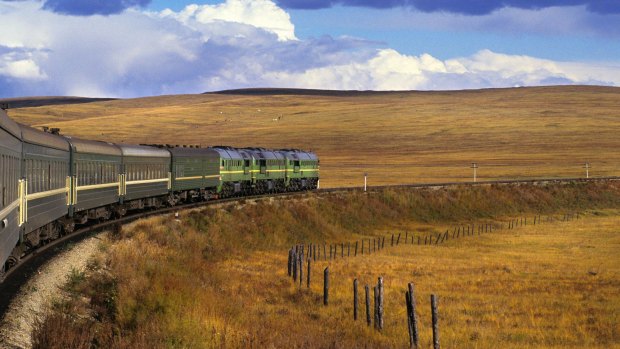This was published 7 years ago
The Trans-Siberian railway turns 100: Facts, figures and how it was built
In the late 19th century Russia was a growing world superpower but its influence and trade was located almost entirely in the West, with great cities such as Moscow and Saint Petersburg. The East of the country, meanwhile was cut off by Russia's huge landmass, with even roads few and far between.
In 1891, Russia's government led by Tsar Nicholas II, ordered that a railway be built between Moscow and Vladivostock, thousands of miles away on Russia's eastern coast and a port in the Sea of Japan.
The result was the Trans-Siberian railway, which traverses seven time zones and 9289 kilometres. It was finally completed in 1916, as the world was at war. 100 years later it remains the world's longest railway line. Last week, Google marked the centenary with a commemorative Doodle featuring animated scenes from the railway.

The epic, 9289 kilometre-long Trans-Siberian railway is now 100 years old.Credit: Alamy
How was the Trans-Siberian Railway built?
The Russian government had been reluctant to spend money on building a railway linking Siberia to the East in the 1880s, seeing little benefit in the prospect, but proposals to build a railway from the region to outside of Russia worried Moscow enough to force their hand.
For this reason, much of the motivation behind the project was simply to prevent rival trade routes, and for this reason, development was hampered by cost-cutting measures: for example, routes went around cities rather than through them, meaning many centres of commerce were abandoned by the railway.
The railway was built over more than two decades by up to 90,000 labourers including soldiers and convicts. Much of the line was completed by the early 20th century, but the route originally went through China finishing touches were not made until 1916.
Because the railway was built on the cheap, it hampered Russia in various conflicts before World War I, specifically the Russo-Japanes war of 1904-5.
How long is the Trans-Siberian Railway?
At 9289km, the Trans-Siberian Railway is the world's largest single railway line. But if you take a detour through Mongolia, it can stretch to a stunning 11,024km.
The whole journey takes around a week to complete, crossing mountains, arctic scenes and forests, and cost around £500.
Some other long train journeys include:
Toronto to Vancouver (4466 kilometres)
Shanghai to Lhasa (4373 kilometres)
Sydney to Perth (4352 kilometres)
Emeryville (San Francisco) to Chicago (3924 kilometres)
What is the Trans-Siberian Railway used for now?
100 years after it was completed, the Trans-Siberian railways is still a vital artery to the Russian economy. It carries more than 250,000 containers a year and some 30 per cent of Russia's exports are said to travel through it.
It has been a vital part of Russia and the Soviet Union's history during both war and peace time. Nowadays, though, it is a key tourist attraction although it is still used largely by Russian citizens.
Tourists can travel in style on the Golden Eagle, a luxury train for which tickets cost as much as £10,000 ($A16,344). Google decided to mark the line's centenary after Matt Cruickshank, one of its Doodle artists, travelled the line in 2015.
The Telegraph, London
Sign up for the Traveller Deals newsletter
Get exclusive travel deals delivered straight to your inbox. Sign up now.